Despite inflation and the ongoing industry recovery from COVID-19, the American domestic and outbound markets continue to grow. Last year, domestic travel spending reached nearly 920 billion dollars: a significant increase from 2021’s 868 billion.1
Slow travel — A growing trend
Published 2 years ago
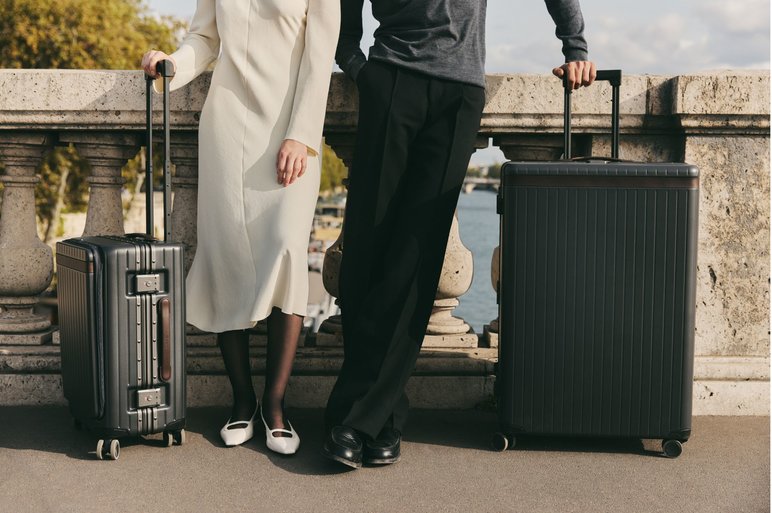
But after returning to travel post-COVID-19, travel trends are shifting. Frenzied box-checking vacations, popularised by books like 1000 Places to See Before You Die or The Bucket List, and jam-packed city breaks are losing appeal. Instead ‘slow travel’ — an approach to travel which is less materialistic and values a more meaningful connection to local cultures — is gaining traction.
But to what extent are Americans really leaning into this slower, more sustainable form of travel? And how realistic is this slower pace of travel for the average working American? We surveyed 1,095 Americans from different industries and ages about their current travel habits and their opinions and experiences of slow travel to find out.

Key findings
-
Over 94% of Americans want to experience slow travel in the future
-
Italy is the trendiest destination for slow travel, followed by Spain and
Germany
-
The average American takes only 8 days to travel on vacation per year,
limiting the capacity for slow travel
-
More than half of Americans find vacations stressful and three-quarters
check work emails or take work calls while on them
-
Break up with city-breaks — nine in ten Americans prefer quieter destinations
and would rather be in nature than shopping or beside the pool
-
The most popular activity Americans look forward to on vacation is consuming
local food and drink: a key element in exploring local cultures
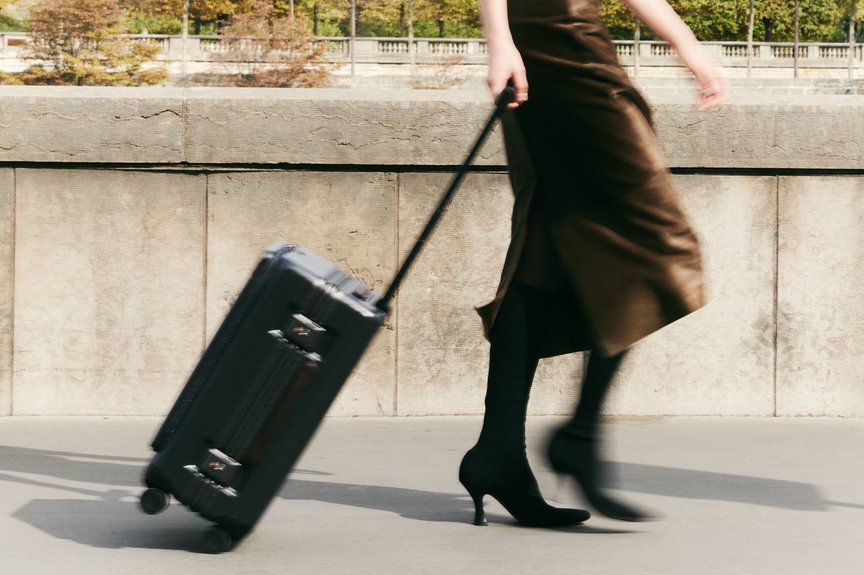
Nine in ten Americans find slow travel appealing
To make sure all respondents were on the same page, we defined slow travel as follows:
“Slow travel focuses on immersing yourself in the destination, engaging with local cultures and having unique experiences. Traditional travel often involves rushing from one tourist hotspot to another, following pre-planned itineraries. In contrast, slow travel is all about prioritising quality over quantity and adjusting your mindset to focus on enjoying the experiences, rather than rushing and attempting to fit in as much as possible".
Not only are three-quarters of Americans already familiar with the concept of slow travel, but after being given a definition, 94.2% would like to try slow travel or slow travel again.
The top reasons Americans are sold on slow travel
Half of those who had already been on a slow travel trip said their favourite aspect of the experience was taking time to enjoy the local culture and scenery (49%). The next top reason was the potential for a more unique or authentic travel experience, with a third (33.6%) responding that they enjoyed sightseeing at less busy or well-known sites.
In general, for those who had or had not been on a slow travel trip, the biggest appeal was meeting locals (43.1%). The next top reasons were to immerse in the local culture (42.4%) and to take the time to fully explore at their own pace (41.5%).
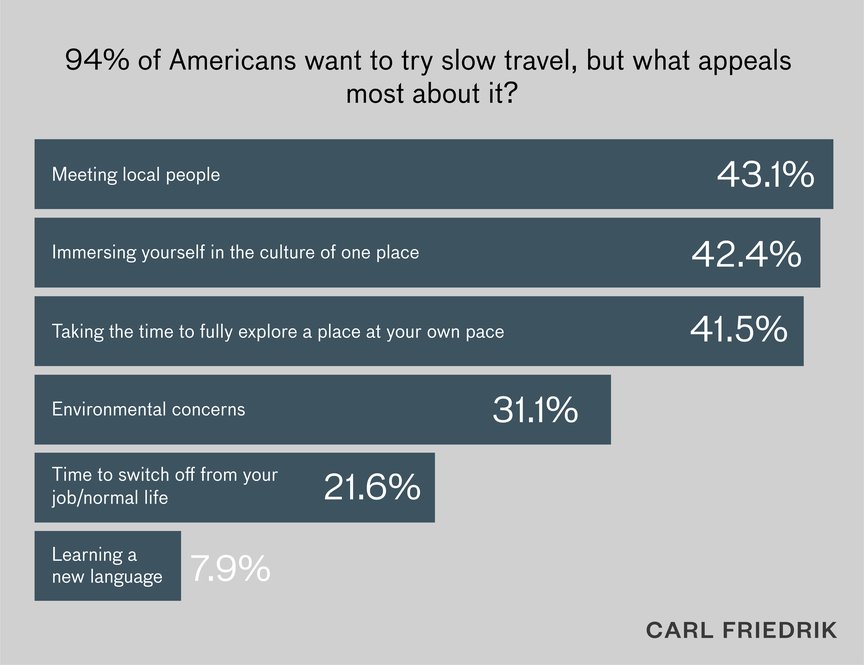
Nearly a third (31%) of respondents cited environmental concerns as an incentive to adopt slow travel methods. In reaction to the jet-setting Instagram tourist stereotype, sustainable travel accounts are gaining traction on social media, including influential activists like Shivya Nath, Jessica Nabongo and Green Global Travel.2 3 4
Slow travel is unanimously popular across generations
Gen Z, those aged between 18-26, are frequently touted as having a less salary-driven approach to work than other generations, instead valuing more holistic benefits like flexibility and sustainability.5
But does this mean that Gen Z are more likely to try slow travel than other demographics? Not particularly. Interest in and experience of slow travel was consistently high across nearly all age groups.
When asked whether they would like to slow travel, 93-96% of the Gen Z, Millennial and Gen X respondents we interviewed were keen to give it a go. Interest remained considerably high in the older age groups too, with 85% of Boomers responding that they were interested in the concept.
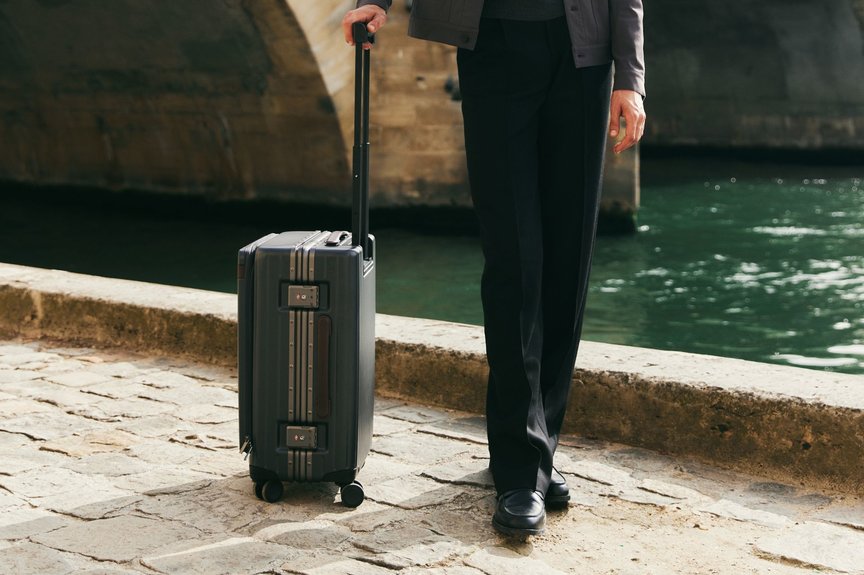
The vacation activity Americans most look forward to is tasting local food and drink
The average American’s favoured aspects of travel are also aligned with the values of slow tourism. When asked what they were most looking forward to, Americans almost unanimously pinpointed experiential travel — in fact, staying by the pool, shopping and nightlife were the least popular incentives to travel.
Another complimentary trend to slow travel is the rise in culinary tourism, which values local produce and supports small businesses. This industry is expected to grow by $126.28 billion between 2022 and 2027.6
Discovering new places (43%) and cultures (40.5%) were some of the most appealing reasons. Although exploring new locations is a top incentive to travel, this doesn’t mean that holidaygoers like to travel between many destinations, instead, most would rather immerse themselves in one place. In fact, 89.8% prefer to stay in one spot for the whole trip — a pace of travel ideally suited to the slow and sustainable travel ethos.
Despite the popularisation of the city break, almost four in ten Americans
would like to immerse themselves in nature on vacation (40.6%) – a more
popular pastime than simply spending time at the beach (37.4%). In fact, 90.6%
of respondents said they would prefer a quieter destination.
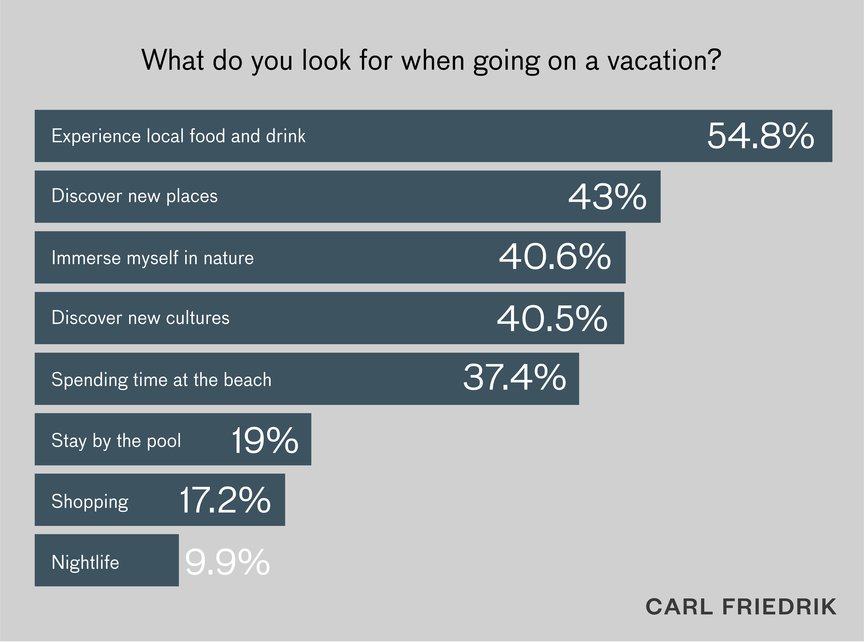
Italy is the world’s most popular slow travel destination
But where are the world’s hotspots for slow travel? To supplement the study, we analysed trending posts on Instagram to find out the most popular places to slow travel.
The majority of mentioned destinations (77%) were in Europe; only 3% of posts analysed were US locations.
A quarter of the top posts in the study featured Italian destinations with the specific region Puglia, the Heel of Italy, coming up time and time again. The next most featured destinations were Spain which was snapped 19% of the time, and Germany with 10%. Completing the top five were England and Portugal.
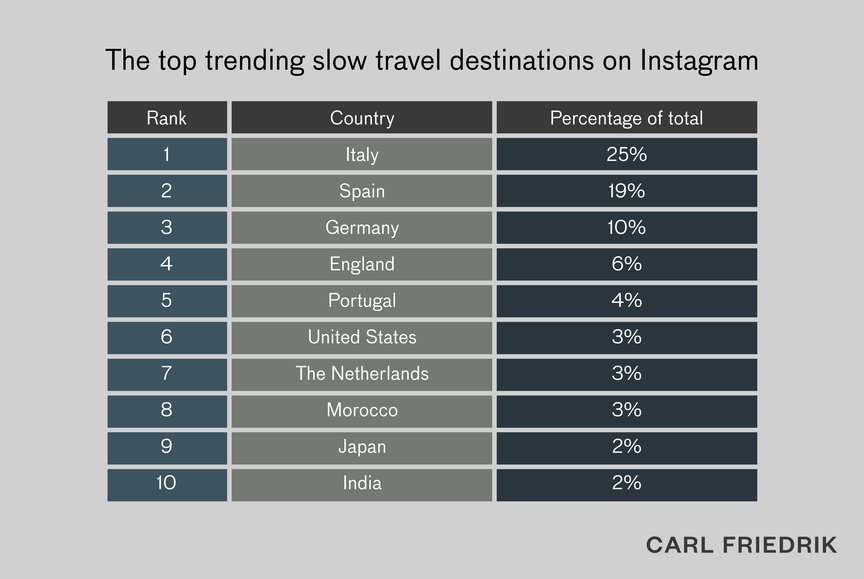
Although 95.3% think more people should practice slow travel, four in ten Americans like the familiarity of going to the same resort or location
Some habits are hard to break. Perhaps wanting to feel like they have squeezed the most out of their time and money, 88% of tourists have some form of to-do list to complete. When asked what is unappealing about slow travel the most common answers were:
-
Preference for a short break (45.2%)
-
Desire to visit the same place or resort/ location (39.2%)
-
Not enough paid time off (25%)
-
Dislike concept of slow travel (14.9%)
Americans take on average just 8 vacation days per year
But the greatest obstacle to the widespread adoption of slow travel isn’t
people’s attitudes: it’s their jobs. Unlike in Europe, where employers are
mandated to grant workers around a month of vacation days per year, in
America it is up to the discretion of the employer how much leave to
give.
Americans were most likely to plan a vacation twice a year (35.7%) or once every three months (25.7%). When they did, they were most likely to take 3-4 vacation days (31.2%) and the majority (79.5%) take between 3 to 7 days off. This limited time (with the most popular amount of vacation totalling just 8 days per year) is barely enough time to practice slow travel, considering that recent research suggests your vacations should last at least one week to reap meaningful health benefits.7
Only 11.3% of Americans typically plan a trip for more than 8 days — so
realistically, only one in ten Americans can truly ‘slow down’ enough for slow
travel.
Remote workers take the least vacations and are most satisfied with their time off
Where you worked also made a big difference to how often you went on vacation — and how relaxed you felt after. Onsite and office workers were the most likely to book a monthly trip (16.6%). Meanwhile, remote workers were the most likely to book a trip annually (25%), every two years or even less frequently. Remote workers were almost twice as likely to feel satisfied with the time off they took, whereas 93.6% of office workers said they needed more time off to properly switch off.
But this doesn’t mean that remote workers are more likely to opt for a slow travel trip. Perhaps needing a break from the office buzz, office and onsite workers were slightly more likely to say they would like to try slow travel with 95.4% saying yes, compared to 92.3% of hybrid workers and 90% of remote workers.
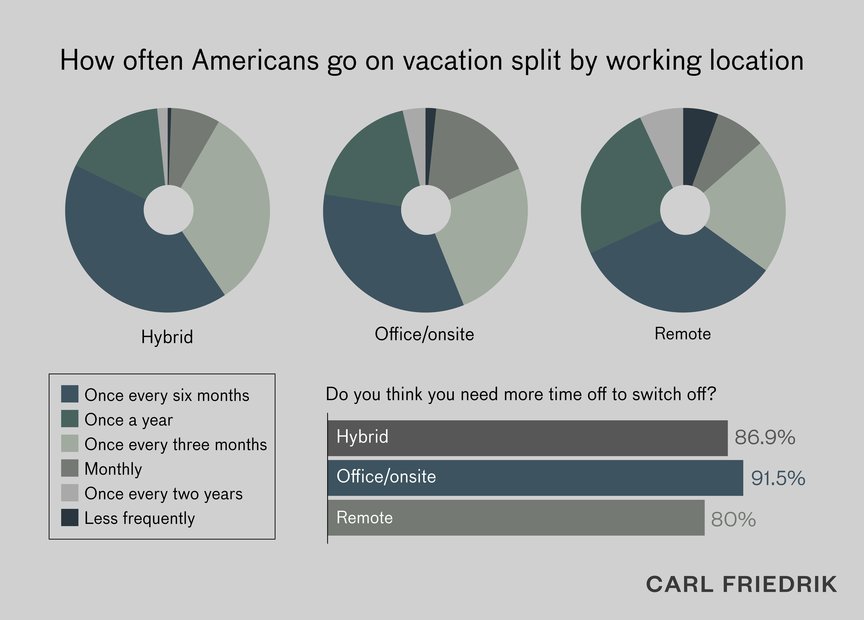
Three-quarters of Americans check work emails on vacation — and four in ten return to an inbox of 50+ emails
Completely contrary to the slow travel ethos, Americans are more likely to
be immersed in their email account than the local culture on holiday. Recent figures by
the American Institute of Stress indicate that 62% of Americans report high
levels of workplace stress and 33% experience constant but manageable
stress.8
However, eight in ten Americans experience stress whilst preparing for or returning from vacation. Considering the fact that 76.3% of Americans feel the need to take work calls or check work emails on holiday, it is unsurprising that 89.9% also responded that they needed more time off to switch off and enjoy time away from the desk.
Despite so many checking in on work whilst away, 42.6% of Americans found the return to work stressful. Three in ten Americans return from holiday to between 11 and 50 emails, but four in ten return to even more in their inbox.
But Americans are just as stressed – if not more – by the trip itself. The
most stressful part of the holiday was travelling to and from the destination
(40.5%) followed by packing (33.1%) and booking a holiday (26.7%). Only 17.1%
responded that they didn’t find any aspect of vacations stressful.
Takeaway
Our study confirms that slow travel isn’t just a niche tourism trend, but a more sustainable way of travelling with mass appeal across all age groups. But although slow travel provides the perfect antidote to high-stress, fast-paced lifestyles, for more people to enjoy its benefits American professionals might need to take a leaf out of their European counterparts when it comes to switching off and taking sufficient time away from the desk.
Sources
- https://www.statista.com/statistics/207075/domestic-travel-spending-in-the-us-since-2002/
- https://www.instagram.com/shivya/?hl=en
- https://www.instagram.com/jessicanabongo/?hl=en
- https://www.instagram.com/green_global_travel/?hl=en
- https://www.zurich.com/en/media/magazine/2022/how-will-gen-z-change-the-future-of-work
- https://www.technavio.com/report/culinary-tourism-market-industry-analysis
- https://www.condorferries.co.uk/us-tourism-travel-statistics
- https://www.stress.org/workplace-stress
Methodology
We surveyed 1,095 Americans in October 2023 about topics relating to vacations and slow travel.
The age breakdown of the people we surveyed was as follows: 18-26 (8.5%), 27-42 (65.8%), 43-58 (21.9%), 59-77 (3.7%) and 78+ (0.1%).
The gender breakdown was as follows: female (52.6%), male (46.8%) and non-binary (0.5%).
To uncover the top slow travel destinations we analysed the location tags of the top 100 #slowtravel Instagram posts on 9th November 2023.